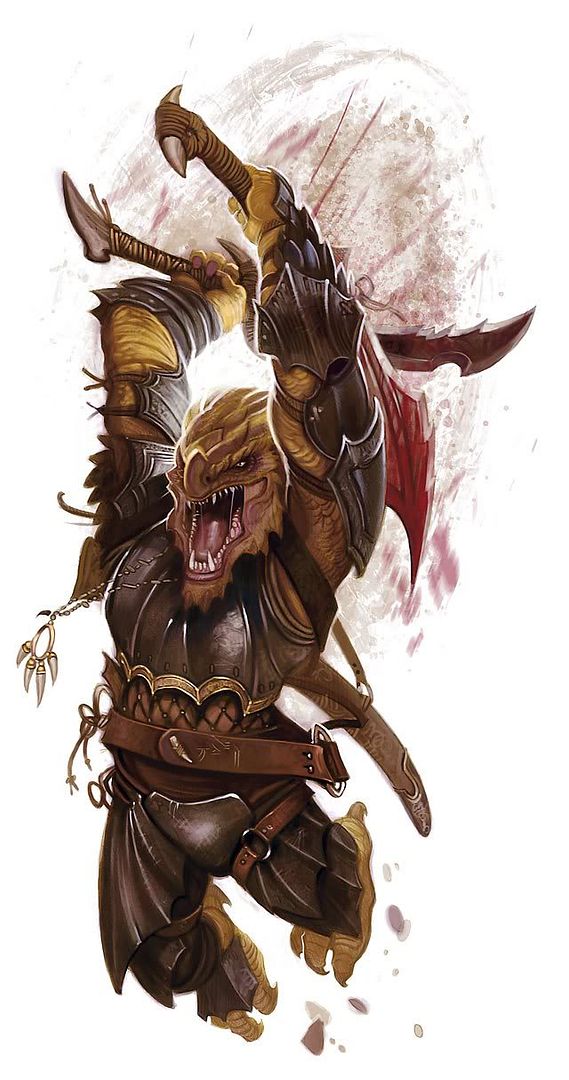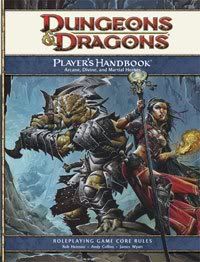
The band Rush said it best in their song "Tom Saywer": Changes aren't permenant, but change is. Inevitably things change and evolve and this is especially true in the gaming world. Consoles come and go, franchises are created, updated, and eventually abandoned. The next iteration of Dungeons and Dragons, the ultimate expression of mainstream nerddom, is upon us and with it a slew of new changes to the most popular role-playing game to date.
So what's different about 4th edition, you might ask. Based on the material that's been released from playtesters and Wizards themselves, there are some major changes in the game regarding the abilities of the player characters (PCs). If you're familiar with D&D 3.5 and more specifically the Tome of Battle: Book of Nine Swords (Bo9S), some of the changes are going to look very familiar. Bo9S introduced a new mechanic for melee characters to use that are similiar to spells cast by wizards and clerics. These maneuvers were special abilities generally geared for combat that scaled just like spells. Moreover, the use of these abilities were not restricted to "per day" basis like spellcaster, nor were they as unlimited as the warlock's at-will abilities. Rather, they were automatically refreshed after every encounter or fight. A character using these manuevers could even change them out with 5 minutes of meditation, allowing for greater versatility.
4th edition borrows this "per encounter" idea, as well as the at-will abilities of the warlock quite heavily. In 4th edition every PC, from the fighter to the wizard has a collection of at-will, per encounter, and per day abilities. These abilities are called powers and come from different sources depending on the character. The duration of these powers has also changed. Some are instant, others last until the end of the encounter, and others last until the target character makes a successful save. No more ticking off rounds for effects, as the consequences of spells and abilities now flow more naturally with the situation at hand.
Character creation is also different as there is a standard rate at which all characters gain powers, much like the accumlation of feats in 3rd edition. Speaking of feats, they will be granted more often. Even though the Player's Handbook will only have 8 classes (Cleric, Fighter, Paladin, Ranger, Rogue, Warlock, Warlord, Wizard), the options for these characters are increased with the selection of powers in addition to feats and skills. Characters are also relegated to different roles including Defender, Skirmisher, Controller, and Leader. Paladins and Fighters could fill the tank-like Defender role with Rogues and Rangers using their mobility and high damage to make up for their lower AC and hit points. Wizards and warlocks are the controllers of the party, setting the flow of the battle with their spells while leaders such as clerics and warlords use their abilities to buff and heal the party.
So what's different about 4th edition, you might ask. Based on the material that's been released from playtesters and Wizards themselves, there are some major changes in the game regarding the abilities of the player characters (PCs). If you're familiar with D&D 3.5 and more specifically the Tome of Battle: Book of Nine Swords (Bo9S), some of the changes are going to look very familiar. Bo9S introduced a new mechanic for melee characters to use that are similiar to spells cast by wizards and clerics. These maneuvers were special abilities generally geared for combat that scaled just like spells. Moreover, the use of these abilities were not restricted to "per day" basis like spellcaster, nor were they as unlimited as the warlock's at-will abilities. Rather, they were automatically refreshed after every encounter or fight. A character using these manuevers could even change them out with 5 minutes of meditation, allowing for greater versatility.
4th edition borrows this "per encounter" idea, as well as the at-will abilities of the warlock quite heavily. In 4th edition every PC, from the fighter to the wizard has a collection of at-will, per encounter, and per day abilities. These abilities are called powers and come from different sources depending on the character. The duration of these powers has also changed. Some are instant, others last until the end of the encounter, and others last until the target character makes a successful save. No more ticking off rounds for effects, as the consequences of spells and abilities now flow more naturally with the situation at hand.
Character creation is also different as there is a standard rate at which all characters gain powers, much like the accumlation of feats in 3rd edition. Speaking of feats, they will be granted more often. Even though the Player's Handbook will only have 8 classes (Cleric, Fighter, Paladin, Ranger, Rogue, Warlock, Warlord, Wizard), the options for these characters are increased with the selection of powers in addition to feats and skills. Characters are also relegated to different roles including Defender, Skirmisher, Controller, and Leader. Paladins and Fighters could fill the tank-like Defender role with Rogues and Rangers using their mobility and high damage to make up for their lower AC and hit points. Wizards and warlocks are the controllers of the party, setting the flow of the battle with their spells while leaders such as clerics and warlords use their abilities to buff and heal the party.

I'm going to hold off a lengthy retelling of the crunchy bits, as they're readily available to be read and digested, and am going to tell you what I think of the new changes so far. If you couldn't tell already, I'm really looking forward to the new iteration of D&D. I loved Bo9S, and am glad to see it's ideas incorporated into the core game. The generation of hit points as a result of leveling up is now a fixed amount based on your class with your constitution as a bonus only at level 1. I'm also looking forward to see if the designers remedy one of the biggest problems in the game which would be the almost mandatory inclusion of a divine healer in the party. From what I've read, their intention is to make any character filling the Leader role just as capable of keeping the party alive as the cleric. Some of the so-called Paragon Paths seem interesting, the Kensai for the fighter and the Doomsayer for the warlock sounding the most interesting to me. The new core race of Dragonborn has me intrigued, as it's merely a racial template right now.
The whole party role thing, especially the Leader role, is also a concern for me. I fear it'll be possible that warlords are just going to be shitty clerics, nothing will have actually changed, and you'll still need a banda... I mean cleric in your party if you expect to survive in the long term. Another concern is that of arcane implements. Powers are all initiated by something, be it a weapon, holy symbol, or arcane implement like a wand or staff. It always bothered me that in some story setting magic users were powerless without their implements. Harry Potter and Lord of the Rings, I'm looking right at you. I guess it's just as silly as speaking words of magical power and waving your hands around to cast spells, but it still bothered me. I'm also questioning the splitting of the elves (again) into eladrin (snooty high elves) and elves (woodsy wild elves). I think there was room for both archtypes in the same race and when races like half-orcs are being left out of the PHB, I'm a bit skeptical. Some players are also turned off by the seemingly MMORPGish nature of the new system. I don't see that resembling a game like World of Warcraft as an inherently bad thing. D&D it's started as a miniature combat game, and I'm willing to actually get a few sessions in before I damn it for resembling a new popular type of game.
I've got the core books on preorder, so I'm obviously hoping for the best here. We've already got a DM for the new edition lined up and almost ready to go. As for my first character, who apparently will be starting at level 1, I'm going to have to see something really cool to not play a Dragonborn or dwarven fighter. Another player as also expressed interest in the ranger, while our third player has yet to even consider what he might be playing and could very well be rolling up his character the morning of our first session.
To quote another song: The waiting is the hardest part.


0 comments:
Post a Comment